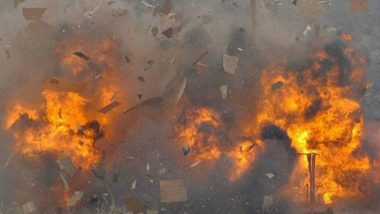Melbourne, October 6: Researchers in Australia have developed a unique technique to prevent glass facades on iconic buildings from shattering if targeted by terrorists in a bomb explosion.
In the study, published in the journal Engineering Failure Analysis, the research team of four from Queensland University of Technology (QUT) looked at the "maximum credible load" of an explosion and how to minimise the problem of a deadly wave of shattered glass which can cause traumatic injury and death. Afghanistan Car Bomb Blast: 15 Killed, Over 30 Injured in Suicide Attack in Ghanikhil District.
David Thambiratnam, one of the researchers, said the study went beyond previous research in the field with a sophisticated coupling analysis, which did not just look at the way the glass responds to an explosion, but also modelled the explosive source, the pressure wave transmission and fluid-structure interaction.
"We modelled the shock waves that travelled through the air and then we studied how it hit the structures," Thambiratnam said. The solution, detailed in the paper, is to absorb the energy of the blast with a shock absorbing layer between the glass panels in the laminated glass and through the members of the supporting system as well as to make the cable trusses stronger.
"The glass is certainly going to crack, but this interlayer holds the particles together," Thambiratnam said. Ruwanika Piyasena, another researcher, said the research was innovative in providing design recommendations for optimised blast-resistant cable supported facades without any expensive external devices.
"Development of the fully coupled modelling technique enabled the realistic modelling of double skin facades and identified the effects of appending an additional skin," Piyasena said. The double skin facades would be two glass skins separated by an air corridor.
"This double skin feature can be used as a retrofitting method for converting existing conventional facades to blast-resistant facades," Piyasena said, adding that "attaching additional skin will be more economically feasible than removing the existing façade and replacing with a new blast-resistant facade, as double skin feature will also provide energy efficient characteristics."
The researchers specifically looked at cable truss facades, which are mostly used in hotel lobbies, shopping malls and airport terminals, where the structure of the large glass area is secured by twin convex and concave cables behind the glass.
The group examined case studies of real blast scenarios and found that up to 90 per cent of blast-related injuries, in bomb attacks, were due to flying glass fragments and other facade debris.
Thambiratnam said previous research had used an uncoupled method of analysis which calculated blast pressure hitting a facade as uniformly distributed, whereas examining the explosive waves in an explosion showed that blast pressures at lower levels of the facade would be higher than those at the upper level.
Piyasena said the developed modelling techniques can be augmented and altered to study the response of debris impact such as hailstorms on cable supported glass facades (by incorporating the load model for the debris in a coupled analysis).













 Quickly
Quickly


